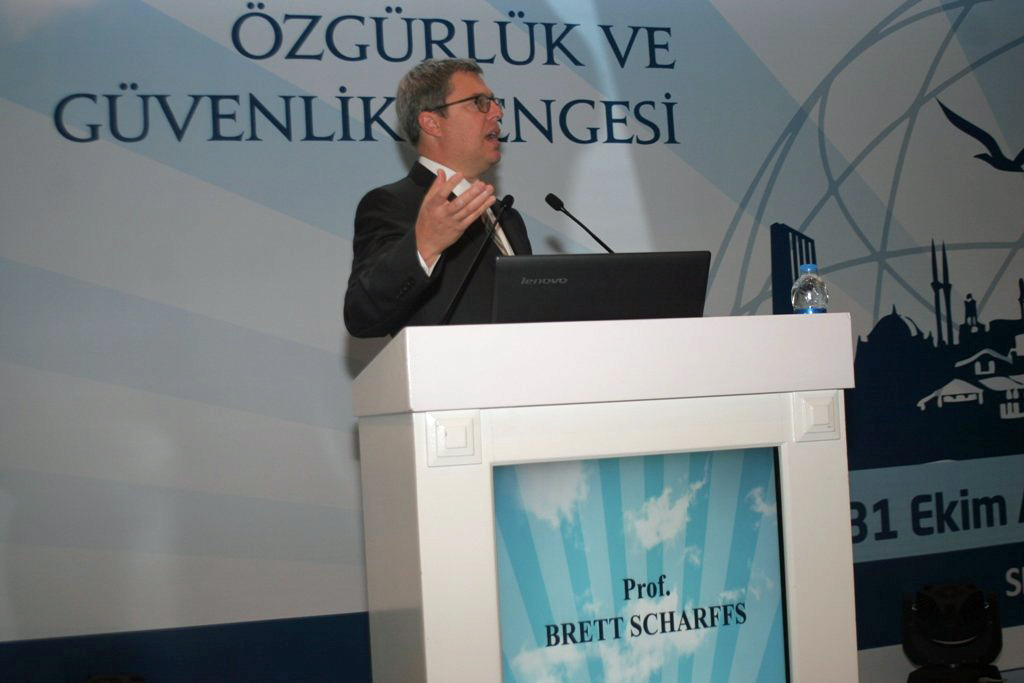Brett Scharffs Presents on Moving Beyond Balancing at International Symposium on Freedom and Security, Istanbul, 30-31 October 2013

J. Reuben Clark Law School Associate Dean Brett Scharffs presented a paper, Freedom and Security: Beyond the Balancing Metaphor at an International Symposium in Istanbul, Turkey on October 30-31, 2013. The symposium focused on the balance between freedom and security in fighting against terrorism and was sponsored by the Justice Academy of Turkey, and included scholars, journalists, judges, and government officials from around the world. In his paper, Dean Scharffs noted that when freedom and security come into conflict we instinctively turn to metaphors involving balancing to guide our discussions of the tradeoffs that certain situations seem to demand. Thinking in terms of balancing is natural because sometimes we really do have to give up freedom in order to have more security, and sometimes having less security will result in more freedom.
But, Scharffs argued, the balancing metaphor also has important limitations, or can even exert a distorting effect on our deliberations. It may make us think that these two values are necessarily in opposition to each other and the one of more can be accomplished only by a relative diminution of the other. A balancing mindset can also place us prematurely into positions of advocacy, with some extoling the value of freedom while others pointing out the importance of security. Third, balancing presumes what philosophers call the commensurability of value – that what is important about freedom and what is important about security can be reduced to some base common denominator, which is often called social utility.
His paper proposed several metaphors that can supplement and even correct some of the distortions that result from the balancing metaphor. One promising metaphor is that of bifocal glasses that helps us shift from one corrective lens to another. Another metaphor is that of color perception, which teaches us that what we see has components of objective, subjectivity, and relativity, working together rather than in opposition. Another metaphor is that of a recipe, which suggests that the goal is not just to maximize each ingredient, but to look for proper proportions, relationships, and techniques. Or we could think of freedom and security as each sources of illumination, and these lights, taken together help us view a situation more completely. Another useful metaphor is to think of freedom and security as two, although only two, of the strands that contribute to the cords that create and hold together the good society.
The paper then suggests a variety of strategies for strengthening the cords of security and freedom, including: taking care to distinguish between groups and individuals; the usefulness of existing legal categories; avoiding all or nothing approaches to thinking about religion; the importance of providing useable mechanisms for registering religious and other civil society groups; respecting church autonomy; treating religious groups equally; anticipating unintended consequences of repression; looking for non-juriscentric solutions to problems; enhancing communication among religious groups and between the state and religious communities; and differentiating society’s interests and those of the ruling political coalition.
Rather than thinking of freedom and security as values in opposition to each other, one to be weighed against the other, we can seek to find ways in which the values of freedom and security can both be jointly enhanced. If we think of freedom and security as two of the strands that make possible the creation of social cords that help bind together good societies, we can try to identify strategies for the mutual enhancement of both of these values. Religious autonomy and security are two vital parts of this cord of community. Our primary goal should be to improve the strength of each strand of this cord, rather than favoring one strand at the expense of another. The goal is to create cords that are strong, flexible and resilient, which will help a community withstand social tensions.
An abstract of the paper was published in the Conference Proceedings and the complete paper will be published as part of a book that will collect select papers from the conference. Here is a link to the PowerPoint presentation.